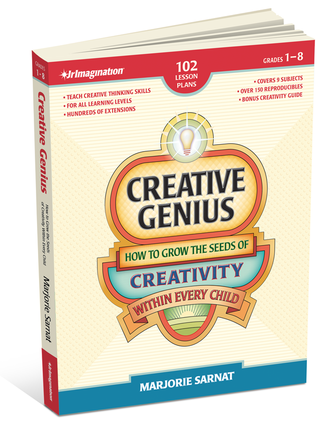Imagination Knows No Bounds
 Monday, August 1, 2011 at 11:01AM |
Monday, August 1, 2011 at 11:01AM |  Marjorie Sarnat
Marjorie Sarnat I recently provided an after school enrichment program at a local elementary school. I was trying out some new ideas to spark creative thinking in kids. The program was only open to students in 2nd to 5th grade, but the principal of the school mistakenly invited kindergarteners and first graders to join, too.
When I arrived at school the principal told me that the little ones had no other place to go during the program, so I had to include them. I was concerned because I didn’t believe children so young could possibly keep up with the older ones. I was wrong.
I prompted the group of 14 to generate new uses for everyday items (see "What Can You Do with a Paper Clip?"), sketch imaginary animals, make up stories based on random images, invent new toys, and solve outrageous problems. The youngest ones eagerly embraced the challenges and ran circles around most of the 4th and 5th graders.
I was surprised at first, but as the class continued, a truth about creativity became clear: The older kids were worried about “looking stupid” and afraid to reveal unusual ideas for fear their peers might laugh at them. They filtered their thoughts and reined in their imaginations. Sometimes creativity has much to do with state of mind and little to do with age. The youngest kids simply had fewer inhibitions and let their imaginations run wild.
The older children needed reassurance that they would not be ridiculed for their ideas. Eventually they became more relaxed and let their creativity begin to emerge. What imaginative ideas they had kept hidden!
Wild, outrageous, weird, and stupid-sounding ideas are part of the creative process, and at times have come from the minds of the world’s greatest creative geniuses. Crazy ideas deserve respect because they could be the seeds of great inventions and innovative achievements. Ideas that are off the beaten path lead to discovery and achievement.
Whether in the home school or classroom, here are seven suggestions for providing an emotionally safe setting for nurturing creative thought:
- Welcome and respect odd and unusual questions.
- Do not allow other students to laugh at, scoff at, or verbally discount fellow classmate’s ideas. Be emphatic about this.
- Find something positive in every idea.
- Reward creativity in your students through verbal praise, with “Creativity Awards,” or with other incentives.
- Encourage and expect creativity from all your students.
- Add grade points for creativity in your lesson evaluations.
- Model creative behaviors yourself, such as being open to possibilities rather than only looking for “right” and “wrong” answers.
In addition, I invite you to download this free mini-poster of Rules for Brainstorming, devised especially for children in group brainstorming sessions.
Keep an open mind to your students’ creative potential and continue to present activities that value creativity. Offering them fun-filled creative thinking practice will give them the opportunity to astonish you.
 answers,
answers,  brainstorming,
brainstorming,  conduct,
conduct,  creative thinking,
creative thinking,  creativity,
creativity,  fluency,
fluency,  workshop
workshop 


